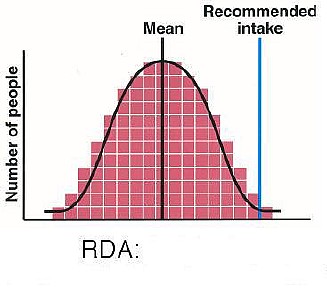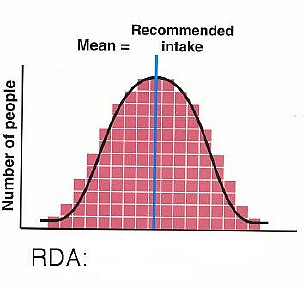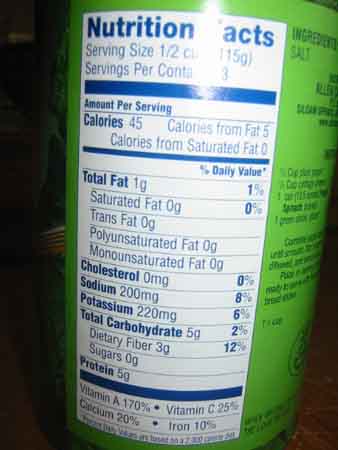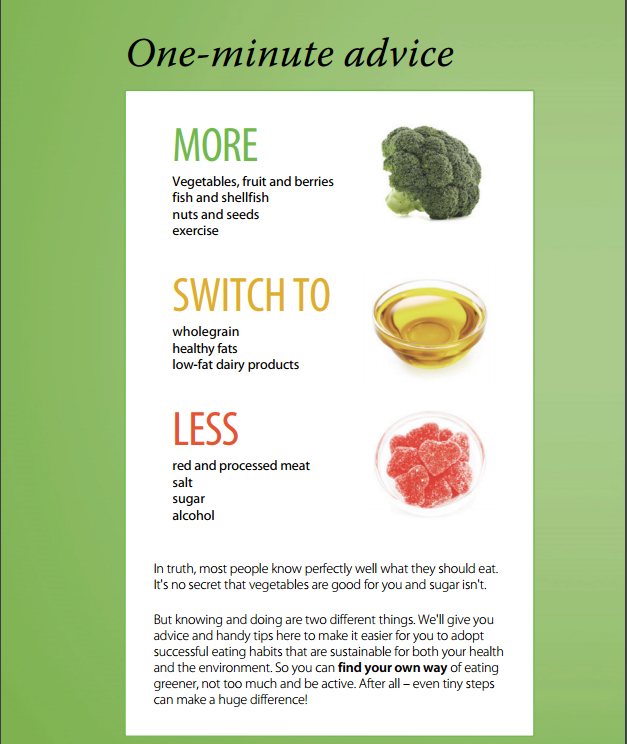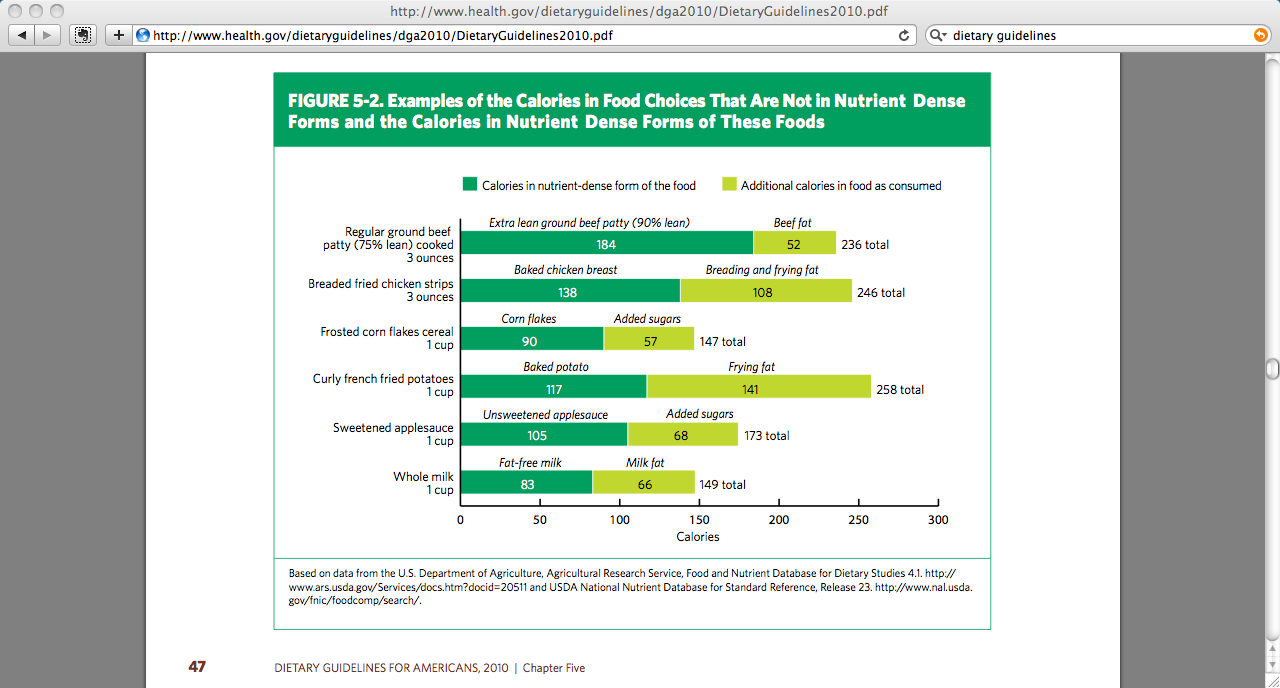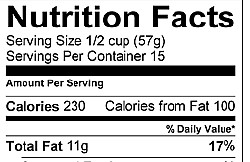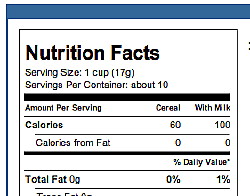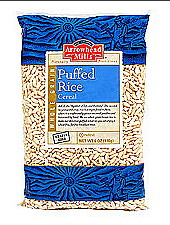|
CORRECTIONS/HIGHLIGHTS/ANNOUNCEMENTS: When you e-mail me in moodle please make sure you tell me what class you are in. If you are needing me to make corrections or edit your online work please be specific about what assignment and what questions you need corrected. Great job using the forums to ask
and answer questions. Remember using the forums will
be the quickest way to get an an answer to your
questions. For Exam 1 during Week 3, you should study:
Also there is a study guide posted and a review quiz during Week 2 . Even though this review quiz is only worth 1 point I strongly encourage you to submit it as there will be questions on the exam taken directly from this quiz. Some of the questions on this review quiz are topics students struggle with most. I also highly encourage you to participate in the wiki for week 2 where you can collaborate on studying for the exam. |
|||||||||
FORUM topics for Week 2 I hope you decide to participate. I've
really enjoyed your postings. Remember there
will be exam questions taken from the forums. I
will post a forum titled, "Student Questions."
Please post your questions here that you have related
to the content of the class instead of e-mailing me
your questions. If you are having trouble
filling out the lecture outline, or answering study
questions, or just need more explanation on a
particular concept use this forum to get help from
other students, and also the instructor. You are
doing a great job of doing this so keep up the good
work! The below topics will
also be posted for you to discuss Week 2. Remember, you don't
have to participate in all of the conversations. The requirement
is to post twice per week. This can be a reply to my original
posting or a reply to another student. Make sure you read the
conversations before posting and try to contribute something new
to the conversation. If you reply to another student and build
on their reply it helps the forums feel more like a conversation
and keeps them more interesting.
1. What did you read about in Chapter 2 that you can apply to improve your eating? 2. View the following blog to compare the MyPlate recommendations to Harvard's Healthy Eating Guide. Also read Marion Nestles deconstruction of MyPlate, and the nutrition debate in Chapter 2 of your text, "Will MyPlate Promote America's Health?" Do you think that the MyPlate graphic or Harvard's Healthy Eating Guide graphic and website will help you design a more healthful diet? Which of these two guides do you prefer, and why? 3. Take a look at a label in your pantry or refrigerator for a snack item. What is the product you looked at? What is the serving size listed on the nutrition label? What would your typical portion be? How does your portion size and the serving size compare? How many Calories in your portion verses the listed serving size? What nutrients is this product a good source of (>10% DV)? Use the below video to help with this activity (also posted in the lecture below under the Daily Values). See more below.
Here is a link to the above video: https://youtu.be/L9EhG-yeadY Also, look at Figure 2.7 in your text that lists the food groups and what nutrients these foods provide. Are there any nutrients listed in Figure 2.7 that don't show up on the Nutrition Facts? If so which nutrients? Do you think this product is nutrient dense? The best way to determine this is to look at the ingredient list. Do the ingredients list mostly whole foods or refined foods?
Remember you don't have to participate in all of the above discussions. You only need to post twice, but the more you participate, the better our discussion will be, and the deeper your learning will be. |
|||||||||
|
Chapter 2:
Designing a Healthful Diet
Remember you will be asked a few mystery questions in your Study Questions about your lecture notes. First look through the major headings of this lecture: I (DRI) Dietary Reference Intakes (pages A-4 to A-7 in back of book) II Daily Values (DV) III Dietary Guidelines for Americans, 2015 (A-3 in book and see link in lecture, below) IV MyPlate (see link in lecture, below) V Beyond the nutrients of the twentieth century
You might be thinking this all sounds a
little too technical and IT IS! Or you might be
thinking: How do I know if my diet is giving me the
nutrients I need? How do I
know if I'm getting enough calcium or iron? As I mentioned earlier, the
RDAs (and the AIs) are usually used in clinical or
outpatient settings, where a dietitian might use them
to assess an individual's nutrient intake. They
also may be used to determine a formula prescription
for a tube feeding. You will use them in this
class to assess your own nutrient intake when you
analyze your diet using the MyPlate website. For the
most part, individual's don't use the RDAs and AIs,
because people eat FOODS not NUTRIENTS, so the MyPlate
is a much more useful guide. That is what we are
going to discuss soon, after we spend a few minutes on Daily
Values.
On May 20, 2016, the U.S. Food and Drug Administration (FDA) finalized significant changes to the current food labels. The FDA extended the compliance dates for the Nutrition Facts label from July 26, 2018 to January 1, 2020, for manufacturers with $10 million or more in annual food sales. Manufacturers with less than $10 million in annual food sales receive an extra year to comply – until January 1, 2021. The change I am most excited for is the addition of added sugars on the new labels. It is virtually impossible with the current labels to determine how much sugar is coming from natural sources like fruit, and how much is added by food manufacturers (we will discuss this more in Chapter 4). If you want to learn more about the changes you will see on the new labels, the here is a great overview, https://www.fda.gov/downloads/food/labelingnutrition/ucm511646.pdf Below is an image comparing the current food labels, and the new label.
Next, we'll talk about the Dietary
Guidelines and MyPlate, but you
might need a stretch break first! STRETCH BREAK! (my now almost 12 year old daughter
stretching on my lap when she was only 9 months old)
Definition-
The plate is a visual representation
of the USDA food guide. It was released in June of
2011, after going through a makeover from the previous MyPyramid. The overall information of MyPlate is the same as MyPyramid, but the format has been modified from a pyramid to a plate. It is a food guide to help Americans achieve the goals of the Dietary Guidelines for Americans, as well as meeting the RDAs and AIs or (DRIs). For most people this means eating MORE:
And LESS:
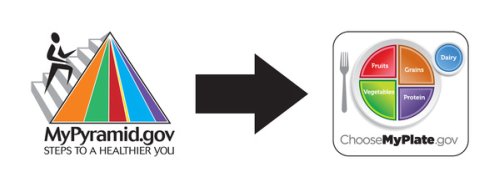 Above is how the icon for the MyPyramid has transitioned to a plate and below is what it looked like when it was first released in 1992. 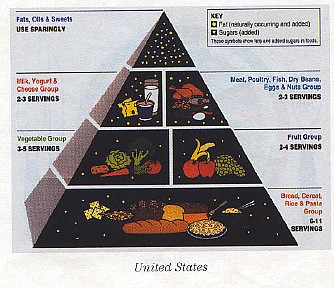 In all three icons above, foods are grouped into 5 different groups, based on their nutrient content.
There are other food guides in other countries,
some in pyramid shapes, and some in other shapes: 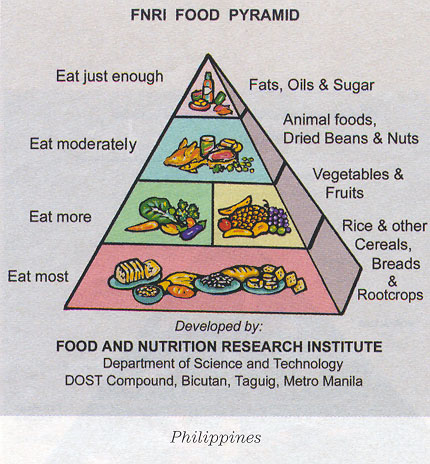 Philippines 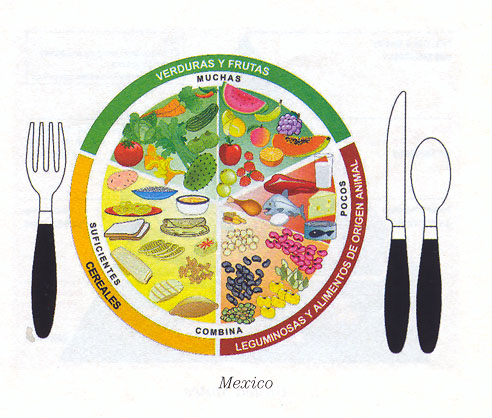 Mexico 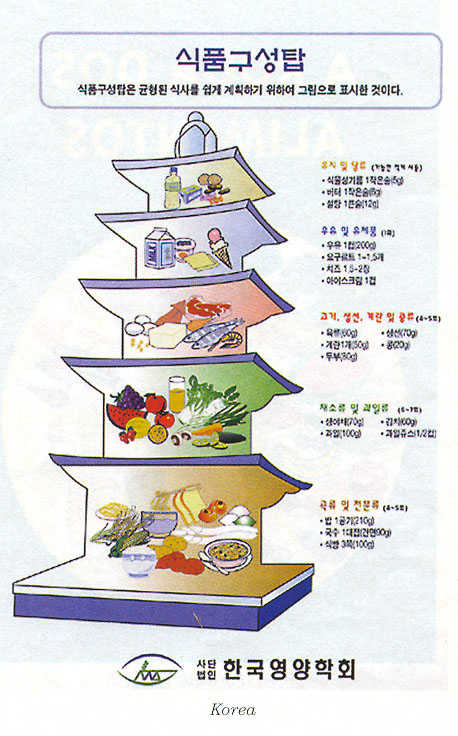 Korea |
The first U.S. Food Guide, shown below, was
released in 1917.  |
|
History of U.S. food grouping systems: (not tested on these
dates) 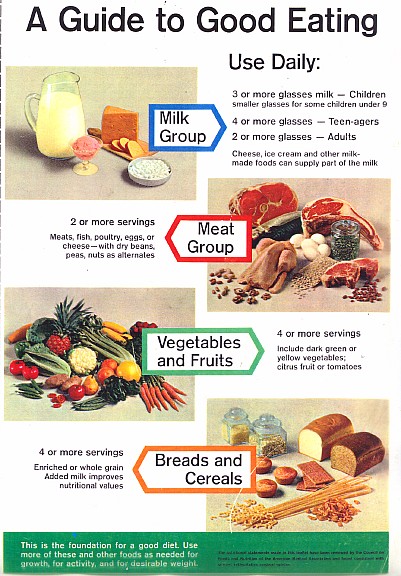 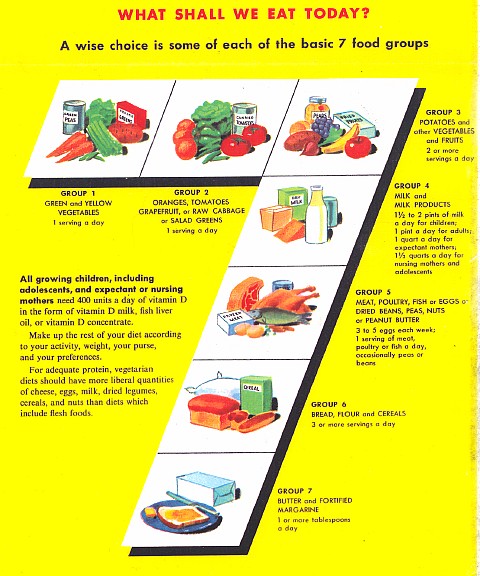  Returning to the U.S. MyPlate (http://www.ChooseMyPlate.gov,) MyPlate encourages people to take a balanced approach and to eat a variety of nutrient dense whole foods. To help people control calories and prevent weight gain, the USDA promotes the concept of nutrient density and empty calories. Controlling Calories: Nutrient density and empty calories. Nutrient density measures nutrients provided per calorie of food. For example, in the screen shot below, a 90% lean 3 ounce ground beef patty is considered more nutrient dense than a 75% lean patty. In the 90% lean patty, for 184 calories you get protein, iron, and other needed nutrients. On the other hand, a 75% lean 3 ounce patty has 236 calories, but the extra 52 calories add only solid fats, and no other appreciable nutrients.
Click on the following link for the definition of empty calories: The idea is to
choose minimally processed foods in each food
group that have few or no empty calories, as these are
the most nutrient dense foods. Examples of foods HIGH in empty calories:
Examples of Nutrient dense choices:
Can you think of how empty calories might actually help you to eat nutrient dense foods? I don't know about you, but I love putting butter on my cooked vegetables, or honey on my whole grain toast or oatmeal. Adding a little fat and sugar sometimes can enhance the flavor of nutrient dense foods. This is a great way to spend empty calories. They will come packaged with other nutrients, unlike drinking a soda packed with calories and no other nutrients. MyPlate Food Plan: MyPlate makes recommendations for the number of servings to eat daily from each food group. The number of servings from each food group and the maximum amount of empty calories recommended depends on energy (calorie) needs. As shown below, a person needing a 1600 calorie diet may need only 1480 calories of nutrient dense foods to get their needed nutrients. The difference between calories needed to maintain weight and calories needed to provide needed nutrients (about 120 calories) are calories that can be spent on extras like solid fats, added sugars, foods low in nutrient density, or extra servings of nutrient dense foods. When choosing your food selections from the different food groups, most of your choices should be nutrient dense in order to meet your nutrient needs with out exceeding your calorie needs. For example when choosing dairy products they should be non-fat dairy products with no added sugar, like non-fat milk. If instead you chose strawberry flavored, whole milk you would be consuming empty calories due to the fat content and the added sugar. In general the most nutrient dense food choices from the food groups are minimally processed fruits, vegetables, whole grains, non-fat dairy, lean meat, fish and skinless poultry, beans, nuts, and seeds that do not have added fats or added sugars. Below is a screen shot of a
food plan developed from the
Dietary Guidelines/MyPlate for an adult who
needs 1600 calories
per day (why they didn't display
the plan in a plate form is beyond me...): 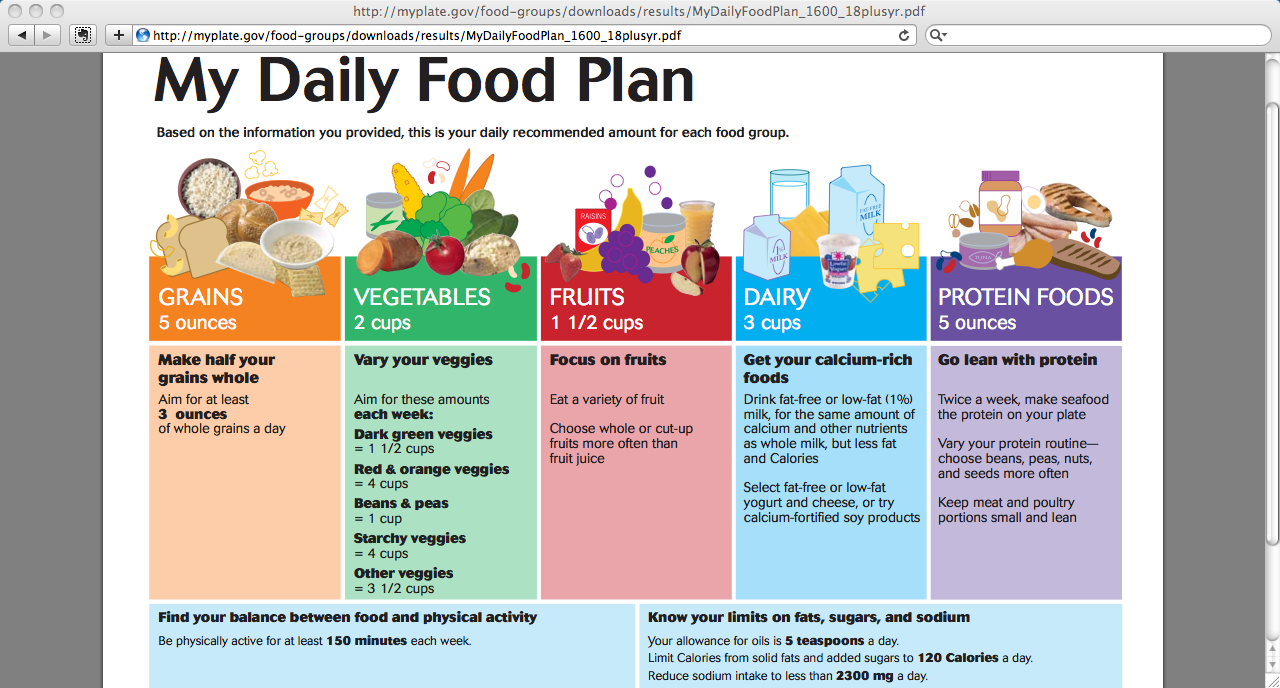 |
||||||||||||
|
Portion Distortion: 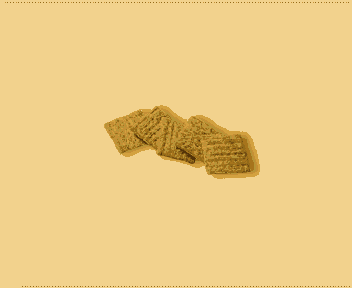 The measurement of that ounce of dry weight varies. You can see in the above image that an ounce of Triscuit crackers is about 5 of them. An ounce is equal to about 30 grams. Dry cereal usually gives the gram weight and the cup measurement.
There is now considerable "portion distortion" in what we think of a serving, as illustrated below. |
||||||||||||
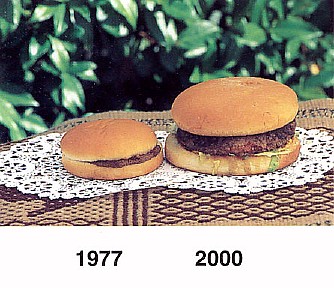 |
||||||||||||
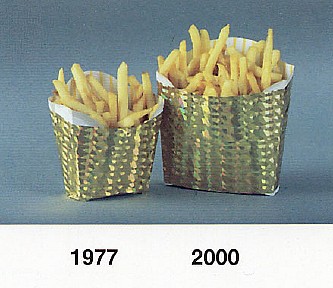 |
||||||||||||
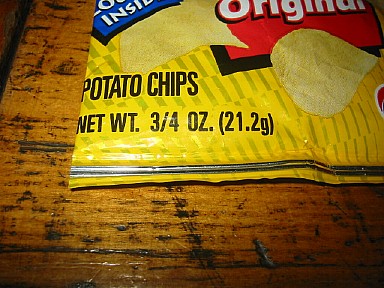 |
||||||||||||
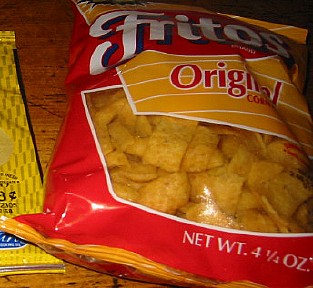 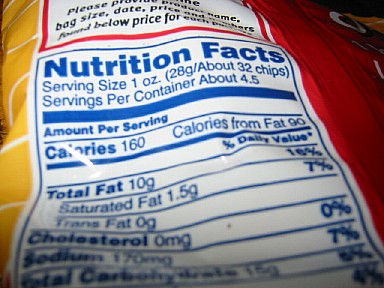 4 1/4 oz. Bag Fritos: 4.5 servings per container The Nutrition Facts
are given for 1
serving.
Do you see where the label says Calories 160 160 calories times 4.5 servings per container= 720 calories/bag |
||||||||||||
| V Beyond
the nutrients of the twentieth century Definition- chemicals that
plants make to help them survive and get ready to reproduce.
Phytochemicals help them do that by helping
Lycopene is an example of a
phytochemical and food companies are anxious to use them to
market their products.
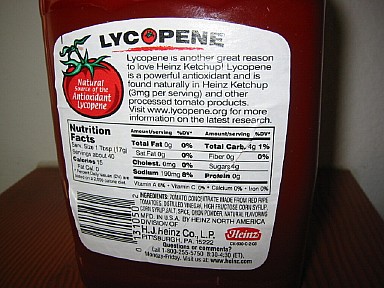 You can find more
than 10,000 different phytochemicals in whole grains, fruits,
vegetables, coffee, tea, wine, beer, herbs and spices.
It is estimated that there may be more than 100
different phytochemicals in just one serving of vegetables.
In her book, Animal, Vegetable, Miracle: A Year of Food Life, Barbara Kingsolver says that a head of broccoli contains more than a thousand phytochemicals. Some companies selling
supplements imply theirs is better than others because it has
"whole food". Nutrition Action, in
December 2007, said that once dehydrated, a serving of fruit or
vegetable (1/2 cup broccoli, for example) would fill some 15
capsules. ("Juice Plus Commission")
The
best way to get phytochemicals is by choosing a variety of
whole plant foods, such as fruits and vegetables and
whole grains. I can't remember where I read or
heard Michael
Pollan
(a contributing writer to the New York Times Magazine and a professor of
journalism at the University of California, Berkeley)
talking about this. He said that for quite a while we've been
encouraged by companies to buy their
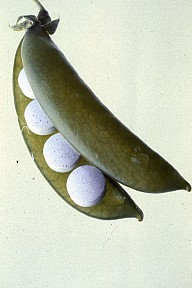 Now we're being encouraged by companies to buy their "pill in a meal".
B. Probiotics and Prebiotics Probiotics- as defined in your text, probiotics are foods or food supplements containing microorganisms that beneficially affect consumers by improving the intestinal microbial balance. Food sources include:
Additional food sources are listed in the following slide show, Slideshow: Top Foods for Probiotics, WebMD. One of the food sources that the slide show mentions is miso soup. My girls attend Yujin Gakuen, a Japanese Immersion Elementary school, and we host Japanese interns that come help out at the school. One of our first interns that stayed with us, Ryoko, taught me how to make miso soup. Below is a video I made of that process.
Prebiotics- according to your text they "are nondigestible food ingredients (typically carbohydrates) that benefit the consumer by stimulating the growth and/or activity of helpful bacteria. By doing so, they improve digestion and metabolism, help regulate the inflammatory response, and in general complement the action of probiotics. The end of Lecture 2A |
